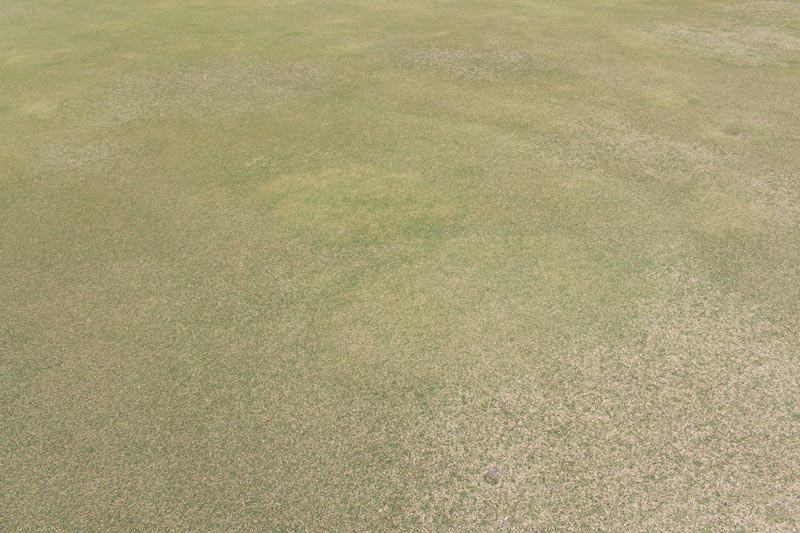
Winterkill injury of ultradwarf bermudagrass greens manifests differently depending on a number of environmental conditions. Here, thin spots are weakened and lack full turf canopy. If not quickly nursed back to health, such areas become open sores that won’t heal without sodding. Photos by James McCurdy
Editor’s note: This article was originally published in the spring 2018 issue of Alabama Green Journal, a publication of the Alabama Golf Course Superintendents Association.
“Winterkill” is a common phrase used to describe the effects of harsh winter conditions on warm- and cool-season turfgrasses alike. Damage is not solely linked to cold weather, however, as not all properties are equally affected. It is not atypical to see a dead lawn adjacent to a lawn that greens up well in spring. Similarly, certain grass species seem to suffer more at different latitudes and because of small differences in growing conditions.
Many factors contribute to winterkill, and attention to cultural practices remains key to prevention. The following proactive strategies can help you decrease the chances of winter damage to your turf.
1. Employ proper cultural practices
The condition of grass in spring is determined by how healthy the grass was going into winter. Proper conditions during the growing season allow turf to grow roots and store up carbohydrates needed during winter and spring. If turf is unhealthy because of improper cultural practices or conditions, the grass will be more susceptible to winter injury.
Mowing height is possibly the most important yet overlooked cultural practice. Superintendents know intuitively to raise mowing heights in fall to allow greens to recover. That means slower ball roll, but it’s cheaper than replacing greens in May and June the following season. Likewise, homeowners and other professional turf managers should increase mowing heights before lower fall temperatures arrive. Some possible exceptions are in overseeded scenarios or on high-end sports fields where athlete performance is a consideration.
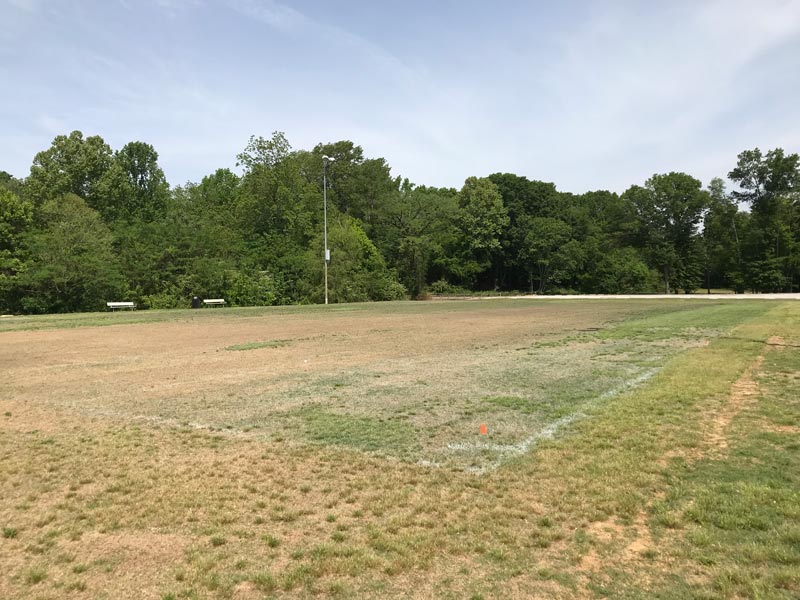
Traffic, such as that from golf carts or sports competition, worsens winter injury.
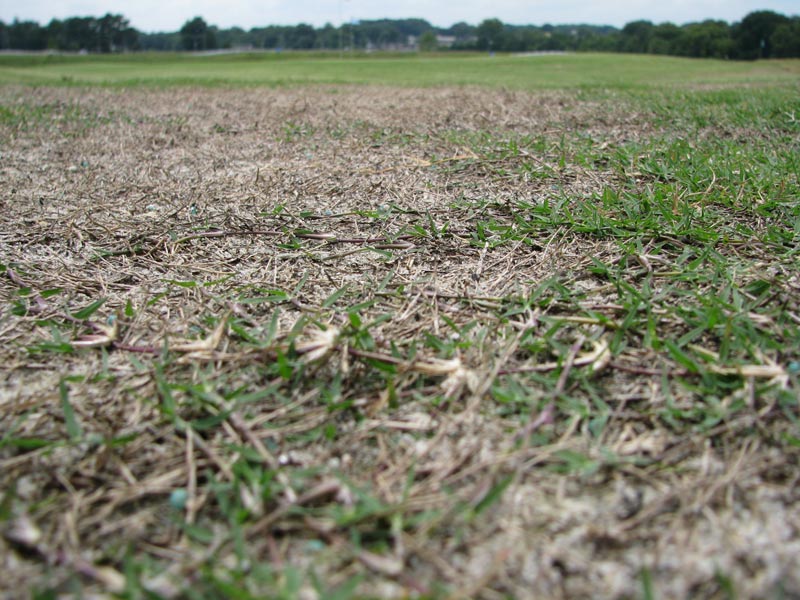
Bermudagrass regrowth depends on carbohydrate and nutrient reserves laid as a foundation in fall and early winter.
Perform aerification and sand topdressing. Root health depends on adequate soil drainage and gas exchange. Many lawns, if not most, would benefit from aerification to relieve compaction and promote root growth. Most golf courses try to core-aerify greens at least once per year and perform other small-tine or solid-tine practices several other times per year. This is almost always combined with frequent and light sand topdressing. Sports field managers should at the very least be aerifying and topdressing high-traffic areas, such as between the hash marks on U.S. football fields and at the goal mouths of soccer pitches.
Regardless of aerification, there is no substitution for proper construction of the soil medium. This means appropriate drainage and nutrient-holding capacity. Shoddy soil construction is all too frequent in modern suburban lots and on school playing fields. Even the best turf professionals cannot solve this problem without heavy equipment.
Reduce tree root competition. Trees are an important part of our landscapes, but the turf beneath them often suffers from drought and limited nutrients because of competition from trees. Root pruning or tree trimming are sometimes the best options to increase turf cover under trees.
Irrigate correctly during the growing season. Overwatering is a common mistake. Proper soil moisture management means irrigation cycles should occur only when needed. Irrigation can be a double-edged sword — in some instances, it mitigates drought stress, but in excess, it causes disease, shallow roots and scalping.
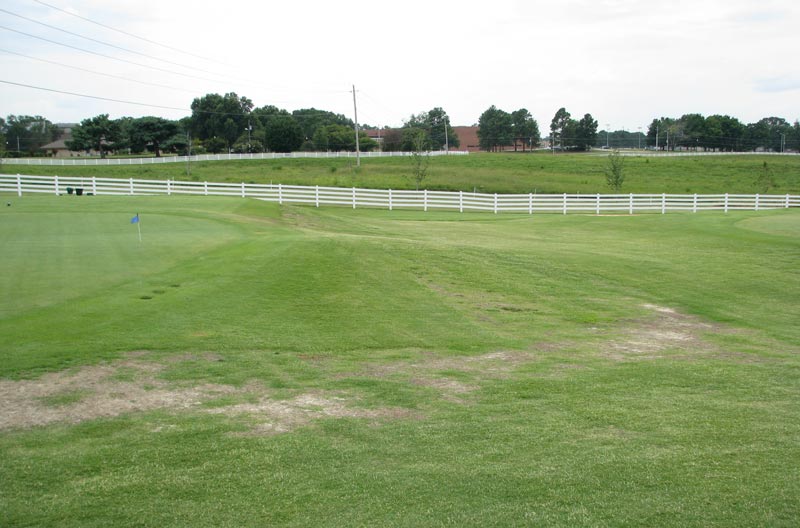
Water confluence areas that stay saturated throughout dormancy tend to be slowest to recover.
Some golf courses have had success applying soil wetting agents prior to harsh winter weather. This is partly thought to reduce plant crown desiccation, but it may also limit frost heaving of soil. Others have had success applying low rates of a plant growth regulator before winter dormancy, sometimes in combination with a wetting agent. The PGR is intended to reduce growth flushes during warming periods or when covers prohibit daily mowing. And of course, a preventive fungicide prior to long periods of covering greens is often beneficial.
2. Let the grass go dormant
Dormancy is an avoidance mechanism for tough winter months when plants can suffer from cold damage, saturated soil conditions, and even desiccation because of dry winds. Fall nitrogen fertilization to enhance or prolong green color is a risky decision. Fall applications of potassium are frequently suggested. In general, if soil test results suggest that a soil contains “medium” or less potassium, then it’s safe to assume potassium applications could be beneficial. There is no substitute for a soil test — period! Keep in mind that potassium uptake is minimal when soil nitrogen is limiting, so an all-around well-balanced fertility program (throughout the year) is necessary.
Likewise, don’t rush spring emergence. Fertility applications to lawns and fairways prior to your area’s historical last frost date are risky.
3. Don’t go overboard with herbicide treatments during fall and spring transition
Herbicides applied in fall and spring can affect rooting of turf, especially when it has been weakened by the environmental factors mentioned previously. Many herbicides affect plant roots of weeds and desired turf alike. In isolated incidences, weakened roots may be more susceptible to herbicide injury than normal.
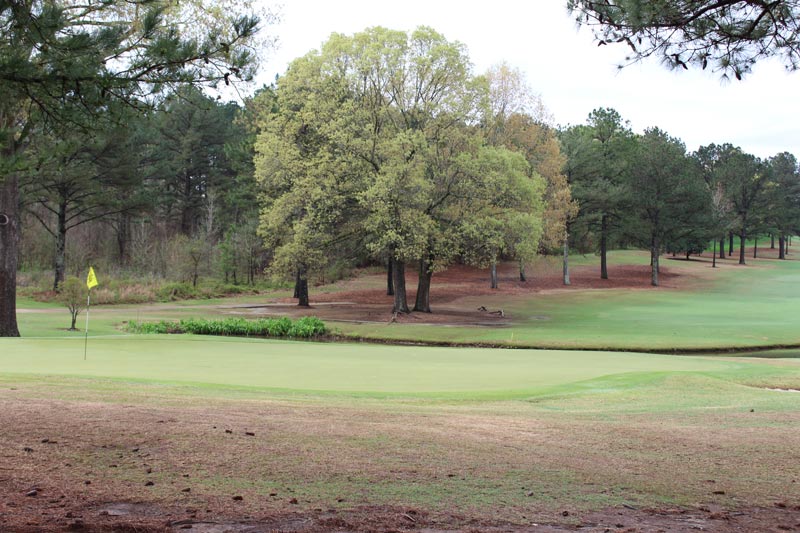
Trees are a fundamental part of urban infrastructure and design, but they exacerbate winterkill, especially on golf course putting greens.
Let me reiterate: Do not rush springtime applications of herbicides following a harsh winter. Even if grass is 100 percent dormant, use caution and rationale when applying nonselective herbicides (such as glyphosate or diquat).
The same is true of selective herbicides. Avoid application of selective herbicides during transition from dormancy to green cover. For instance, auxin-mimicking herbicides, such as 2,4-D and mecoprop, are labeled for use on bermudagrass and zoysiagrass. Simazine is a common go-to herbicide for centipedegrass and St. Augustinegrass during winter months. But for some reason, even these “safe” and “labeled” herbicides can delay spring green-up when applied at improper timings when turf has been weakened by winter.
When possible, avoid auxin-mimicking herbicide applications on St. Augustinegrass and centipedegrass during fall and spring transition. Even if you think these two grasses are dormant, they’re not.
Avoid high rates of pre-emergence herbicides. This is a tricky decision. Here in the Southeast, our spring crabgrass/goosegrass control programs depend on pre-emergence applications at proper timings. That initial pre-emergence timing is roughly late February through mid-March for most of the mid-South. Follow label directions and use conservative rates when appropriate. The publication Pre-emergence herbicide selection following winter stress by my colleagues at the University of Tennessee goes into greater detail on this topic.
James D. McCurdy, Ph.D., is an assistant professor and turfgrass Extension specialist at Mississippi State University.